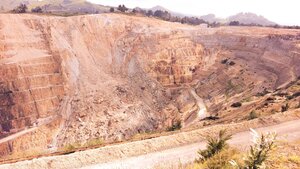The Gold Report: Can you tell us about several companies that you cover that are up substantially year-to-date?
Derek Macpherson: Kirkland Lake Gold Inc. (KGI:TSX), Klondex Mines Ltd. (KDX:TSX; KLNDF:OTCBB) and Integra Gold Corp. (ICG:TSX.V; ICGQF:OTCQX) are all up more than 30%, with Kirkland up almost 70%. We pick companies that are undervalued and have the ability and the necessary catalysts to move higher and close the valuation gap.
TGR: What are the key differences between those companies that are moving higher and the others that are flat or lower?
DM: Companies need to change the story or have good news. That's key. For example, Kirkland Lake is in the process of changing its story. The company is turning around its operation, and is starting to generate free cash flow. That's helping to drive that stock higher, improving its relative valuation.
TGR: Kirkland Lake has a relatively new CEO. What are some qualities you want in a junior mining CEO?
"Integra Gold Corp. is one of our favorite development assets in Canada."
DM: There is a basket of qualities we look for. I don't think that any one quality is critical, but they all need to be there in varying degrees. First, with a junior mining or development company CEO, you want solid technical expertise. Lacking that, CEOs should surround themselves with good technical people. Second, you need a CEO who not only intimately knows the company's story but also is passionate about it and can communicate that passion. Third, they should be able to present the story in a formal setting but also one-on-one with investors. And, finally, a junior mining CEO should have a good understanding of capital markets and how to get things done in capital markets—that can be more difficult to find with junior companies than one might expect. Similar to technical expertise, if the CEO has limited experience with capital markets, being surrounded with people who do is a must. Capital markets expertise makes a big difference when you're trying to move your share price out of that undervalued camp.
TGR: When you meet CEOs for the first time, what do you ask them?
DM: Typically, I am quizzing them about their assets because I want to learn about them. Usually, the first questions that I'm asking a company are a little bit deeper than what you find in the company's investor presentation and are focused on the asset: what's going on, what the company's plans are and what is the potential of the projects. When I have a CEO sitting across from me, I expect him or her to be able to answer those questions.
TGR: What is your 18-month forecast for gold and silver in U.S. dollars?
DM: We see $1,200/ounce ($1,200/oz) gold and $17/oz silver over the next 18 months. That's what we use to value companies.
The downturn in commodity prices has led to a decline in exploration and development spending as companies have reduced spending both as a result of lower commodity prices and the reduced availability of capital. Spending has been declining since 2012, after the gold price peaked in 2011. This is similar to what happened in 1997 through 2001; however, in 2002 global production started to decline, which coincided with a rise in the gold price starting in 2001. About the same length of time has expired since gold peaked in 2011 and exploration spending in 2012. With global mine production likely to decline in 2016 or 2017, a rally in the gold price could be on the horizon; however, the timing is uncertain.
"Klondex Mines Ltd. is likely to have positive news flow throughout the balance of 2015."
TGR: Do you also forecast gold and silver in Canadian dollars?
DM: We don't, but we use $0.80 for our conversion rate. That equates to about CA$1,500/oz gold and CA$21.25/oz silver.
TGR: In a flat metals price environment, is the falling Canadian dollar boosting the margins of Canadian producers?
DM: Yes, that's a key theme we've been focused on lately. When a company is selling its commodity in U.S. dollars and the majority of its costs are in Canadian dollars, it should see margin expansion. With Q1/15 reporting on the horizon, we are likely to see a number of Canadian producers come in with lower than estimated U.S. dollar cash costs, which are likely to be lower than what the companies guided earlier this year because annual budgets would have been completed and approved using a higher Canadian dollar in the latter part of 2014. Canadian producers, along with other non-U.S. based producers, have the potential to see U.S. dollar costs come in below expectations, which is likely to result in expanding margins.
TGR: Do you think the market will react to those cost numbers?
DM: We think the market will, particularly for Canadian producers, where 80–90% of costs can be in the local currency. This is especially true for more labor intensive underground operations like Kirkland Lake Gold or Lake Shore Gold Corp. (LSG:TSX). For other non-U.S. based producers, a lower percentage of costs are in local currency, reducing the benefit of a strengthening U.S. dollar. For example, in Mexico or other Latin American countries, it could be 50–70% in the local currency, depending on underlying agreements and how developed mining is in that country. We expect the stocks to react as financial results are reported for Q1/15.
TGR: Are lower oil prices helping, too?
"We expect to see some good drill results from Source Exploration Corp.'s Las Minas project over the next three months."
DM: Lower oil prices are certainly providing some benefit for all mining operations; however, large open-pit operations in remote locations are likely to see the largest impact on costs. With our coverage universe mostly consisting of underground operations, there is a reduced benefit. It is difficult to quantify the magnitude of the impact but it should provide a tailwind for most operations.
TGR: Tell us about some of the companies that you cover that continue to perform in a rather bearish market.
DM: One of our favorite names continues to be Klondex. It has two high-grade mines in Nevada. We like high grades in a volatile metal price environment because they provide protection for margins and can provide operating flexibility. With the company ramping up production and actively exploring at both assets, it is likely to have positive news flow throughout the balance of 2015 to support the stock.
TGR: Is the market giving Klondex sufficient recognition for both Midas and Fire Creek?
DM: Not yet, but the recent share price performance may suggest the market is starting to reflect the potential of both assets. Klondex recently published some drill results from Midas that continue to highlight the high-grade nature and longer life of that mine. Obviously, we continue to like Fire Creek; it has exceptional grades and has the potential for the mine-life to grow. We believe a portion of the discount that Klondex trades at relates to the fact that it is still at an early stage of production, as it has been in commercial production for just over one year. We believe the discount to peers is likely to decline as Klondex continues to execute at both operations.
TGR: Is Klondex starting to gain an institutional following?
DM: It is. We are starting to see a shift in the shareholder base toward institutions and not just traditional mining investors. Some generalists are starting to look at Klondex as a go-to gold name.
TGR: What are some other companies that are performing but still undervalued?
DM: In our view Kirkland Lake continues to be a high-potential name. Management is focused on generating cash-flow rather than simply producing ounces. The result has been improved profitability stemming from an increase in head grades and improved operating costs. One thing that stands out with Kirkland Lake is its guidance. When the company initially provided three year guidance in mid-2014, it did so at 15–20% below the planned reserve grade simply because the company had never previously delivered tons to the mill at the reserve grade. However, for fiscal 2015, which ends April 30, the company has delivered almost 19% above guided head grades, approaching the reserve grade. We are now of the view that the guided head grades are likely going to increase for 2016 and 2017, and that the stock is going re-rate. As grade drives margins, with grades likely to improve, margins should also, so it's certainly going to provide additional free cash flow for a company that is already benefiting from a weak Canadian dollar.
TGR: CEO George Ogilvie cut 200 jobs from the Macassa mine complex and has put together at least three quarters of modest cash flow. What's his next challenge there?
DM: It's continuing to execute. The turnaround has been good so far, and the company has improved its grade and costs. The challenge now is sustaining the same trajectory that it has developed and continuing to improve beyond this initial stage.
TGR: Other performers?
DM: One of our favorite development assets in Canada is Integra Gold. We certainly like the asset: just over 1 million ounces at 9.8 grams per ton gold in Val-d'Or, Quebec; it is certainly worth looking at. Integra has an aggressive management team that has been able to continue advancing the project in a very challenging market. It is on the verge of starting initial underground development, for advanced exploration. Integra continues to be undervalued, particularly considering its low potential capex and secured milling solution.
TGR: We know there is gold at the Lamaque gold project and Integra has a mill, but does this company have the cash it needs to continue development?
DM: Obviously, being a pre-production company, Integra will need to raise some additional capital to complete its advanced exploration work and move into production. But the company has proven in the past that it is capable of doing that. Good assets attract money even in tough markets and the advanced exploration stage is important for investors, since despite being in a historic camp and being near the Sigma-Lamaque mines where the geology is well understood, advanced exploration is the next de-risking step for the project. It should provide a greater understanding of how the ore body is relative to what the drill results predict. That knowledge will be used to develop a mine plan, refine the current resource and move the project to the prefeasibility/feasibility stage.
TGR: Does Integra have the team it needs to accomplish its near-term goals?
DM: The company has been very good at adding strong technical people at different stages, both at the management and board levels. Recently it has added some technical expertise at the project level, which is very important for moving the project forward.
TGR: Is there more upside left in those three names?
DM: Certainly. All three have been on a good run but we think that they are still relatively undervalued.
TGR: What are your targets on those three names?
DM: We have a $5 target on Klondex, $8 on Kirkland Lake and $0.90 on Integra Gold.
TGR: What are some companies under coverage that haven't performed year-to-date but could rebound in H2/15?
DM: We cover two companies that certainly could. One is Timmins Gold Corp. (TMM:TSX; TGD:NYSE.MKT). Timmins started off the year strong and then, after the proposed acquisition of Newstrike Capital Inc. (NES:TSX.V) was announced, fell out of favor. The market's objection to the deal appears to be that Timmins didn't necessarily need a second development asset because it just closed the acquisition of Caballo Blanco. Our view is a little different. We think that Timmins is poised to build itself into a midtier mining company. It can generate free cash flow from the San Francisco mine, and use that as a platform to build these other two assets. Caballo Blanco is a relatively simple project. Timmins certainly has the expertise to put that project into production. While Ana Paula is slightly more complicated and is in a jurisdiction with elevated security risk, it is unlikely to be developed until after Caballo Blanco is brought into production.
TGR: Is Caballo Blanco the right asset for right now?
DM: Caballo Blanco is a good fit for the company. Timmins was able to pay a reasonable price because of the permitting challenges experienced by the previous operator. Timmins has an advantage over the previous owner in that its operating team is Mexican and has a good understanding of the social and political issues surrounding the project. As well, the project is a technically simple heap-leach project, which Timmins has the technical ability and experience to bring into production. Ana Paula is an asset for the future. With security risk elevated in Guerrero, Timmins has the luxury to wait and see how things develop over the next couple of years for Torex Gold Resources Inc. (TXG:TSX) as it moves through the final stages of building its project there.
TGR: There has been considerable unrest in Guerrero. Have you put out any notes on what's happening there?
DM: There are some security risks in Guerrero, but Goldcorp Inc. (G:TSX; GG:NYSE) operates a mine there, and Torex is building one. Guerrero has a history of security issues, but part of our view is that as the area develops, that security risk could be reduced. We model construction starting in 2017 and production starting mid-2018. The security risks in Guerrero could be different when Timmins needs to make a production decision on Ana Paula.
TGR: What are some others that could perform in H2/15?
DM: Another one is West Kirkland Mining Inc. (WKM:TSX.V). The company has a development-stage asset in Nevada. It's a simple heap-leach project with the potential for a relatively short timeline to production. The company is working on a prefeasibility study that should be published in Q2/15. West Kirkland's approach is likely to be for a smaller scale, higher grade mine than the one envisioned by the previous operator.
Until now, the only economic study on the project was Allied Nevada Gold Corp.'s (ANV:TSX; ANV:NYSE.MKT) preliminary economic assessment (PEA), and that PEA envisioned a higher throughput, lower grade project than West Kirkland. The pending prefeasibility study should provide some clarity to the market. As well, in the near-term we expect a ruling on whether the Three Hills deposit can be developed via an economic assessment, a shorter permitting process, which if used would reduce the project's time to production.
TGR: This is still a penny stock. Does the market recognize the potential at both Hasbrouck and Three Hills?
DM: We're always of the view that good projects attract capital, and this one certainly fits into that category. It is a smaller project and if the market doesn't appreciate it, we think that an acquirer might.
TGR: Tell us about West Kirkland management.
DM: CEO Mike Jones and CFO Frank Hallam have a reasonable track record with multiple successes, the most notable being Timmins West Mining before it was bought by Lake Shore Gold Corp. (LSG:TSX), another company we cover. Jones and Hallam have surrounded themselves with a management team that is focused on project development, which checks off a lot of those other boxes that we spoke about earlier.
TGR: What are your targets on Timmins and West Kirkland?
DM: My target on Timmins is $2.60; West Kirkland is $0.20.
TGR: Are there other stories you would like to briefly share?
DM: There are three development or exploration stories that we've been following that are certainly worth mentioning. One that we just launched coverage on is GoldQuest Mining Corp. (GQC:TSX.V). It's a development-stage project in the Dominican Republic famous for a couple of very good drill holes in 2012 at its Romero project. That's one that has underperformed so far this year. One of the reasons that we think it has a good chance to change that is because it put out an optimized PEA in the middle of 2014. Our review of the previous PEA suggests that it is relatively unoptimized for the current market conditions and the deposit. We're likely to see an optimized PEA in three to six months. That optimized PEA should provide a different value proposition for GoldQuest, and it should help the stock perform in H2/15.
The other two are more early-stage exploration plays. One is Source Exploration Corp. (SOP:TSX.V). It previously had some good drill results at its Las Minas project in Veracruz, Mexico. The company raised some money earlier this year, and that should allow it to start drilling again. We expect to see some good drill results from that project over the next three months, which should help it perform in H2/15.
And one company that we have on our watch list is NuLegacy Gold Corporation (NUG:TSX.V; NULGF:OTCPK). It's an interesting play because it is a junior earning into a project. NuLegacy has enough money to get to the end of its earn-in in October, but at that point, Barrick Gold Corp. (ABX:TSX; ABX:NYSE) has a clawback option. NuLegacy is focused on proving a decent-sized resource. If the resource is large enough to attract Barrick, it would be interesting to see whether Barrick chooses to earn back in or simply acquire NuLegacy. In the interim, obviously, NuLegacy needs to finish its earn-in and is going to be spending money drilling. There is potential for good news flow in the next three to six months.
TGR: Do you have targets on those names?
DM: We have a target of $0.25 on GoldQuest. NuLegacy is a watch list company. Source Exploration is one we are following.
TGR: Please leave our readers with one thought on investing in a bear market.
DM: Investing in a bear market for mining equities is not only about finding quality assets that are undervalued by the market but those companies that have the ability to change the situation. Having that ability, as I mentioned, is both a function of effective management and having the necessary catalysts to change the market's view.
TGR: Thank you for your insights, Derek.
Derek Macpherson is a mining analyst at M Partners; before joining M Partners he worked in mining research for a bank-owned investment dealer. Prior to entering capital markets, Macpherson spent six years working as a metallurgist. Macpherson has a Bachelor of Engineering and Management in materials science and a finance-focused Master of Business Administration.
Read what other experts are saying about:
Want to read more Gold Report interviews like this? Sign up for our free e-newsletter, and you'll learn when new articles have been published. To see a list of recent interviews with industry analysts and commentators, visit our Streetwise Interviews page.
DISCLOSURE:
1) Brian Sylvester conducted this interview for Streetwise Reports LLC, publisher of The Gold Report, The Energy Report, The Life Sciences Report and The Mining Report, and provides services to Streetwise Reports as an independent contractor. He owns, or his family owns, shares of the following companies mentioned in this interview: None.
2) The following companies mentioned in the interview are sponsors of Streetwise Reports: Integra Gold Corp., Klondex Mines Ltd., Source Exploration Corp. and Timmins Gold Corp. Goldcorp Inc. is not affiliated with Streetwise Reports. The companies mentioned in this interview were not involved in any aspect of the interview preparation or post-interview editing so the expert could speak independently about the sector. Streetwise Reports does not accept stock in exchange for its services.
3) Derek Macpherson: I own, or my family owns, shares of the following companies mentioned in this interview: None. I personally am, or my family is, paid by the following companies mentioned in this interview: None. My company has a financial relationship with the following companies mentioned in this interview: Klondex Mines Ltd., Integra Gold Corp., Lake Shore Gold Corp., Source Exploration Corp. and NuLegacy Gold Corporation. I was not paid by Streetwise Reports for participating in this interview. Comments and opinions expressed are my own comments and opinions. I determined and had final say over which companies would be included in the interview based on my research, understanding of the sector and interview theme. I had the opportunity to review the interview for accuracy as of the date of the interview and am responsible for the content of the interview.
4) Interviews are edited for clarity. Streetwise Reports does not make editorial comments or change experts' statements without their consent.
5) The interview does not constitute investment advice. Each reader is encouraged to consult with his or her individual financial professional and any action a reader takes as a result of information presented here is his or her own responsibility. By opening this page, each reader accepts and agrees to Streetwise Reports' terms of use and full legal disclaimer.
6) From time to time, Streetwise Reports LLC and its directors, officers, employees or members of their families, as well as persons interviewed for articles and interviews on the site, may have a long or short position in securities mentioned. Directors, officers, employees or members of their families are prohibited from making purchases and/or sales of those securities in the open market or otherwise during the up-to-four-week interval from the time of the interview until after it publishes.









































